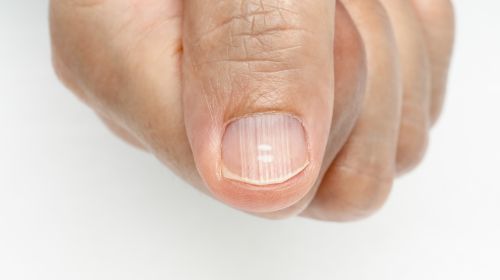Written to the highest scientific standards and checked by experts
The dermatologist can usually recognize nail fungus by the symptoms. The pathogen type is determined with fungal cultures, other diseases should be excluded.
-
- Before the treatment, the doctor determines the nail fungus pathogen under the microscope or using a laboratory culture.
- © iStock.com/sturti
If you suspect that you have become infected with nail fungus, you should not wait long, but rather quickly see a dermatologist. Because nail fungus is contagious: there is a risk of infecting family members and other people. If you wait longer, you also risk that the nail fungus spreads further and further. Treatment of the affected nails then becomes even longer and more difficult.
Exclude other nail diseases
The dermatologist usually recognizes nail fungus by eye diagnosis. However, the typical symptoms such as discoloration and changes to the nail plate are only a first indication of a fungal infection for the dermatologist.
Other diseases can also cause changes to the nails, for example psoriasis or infections with bacteria. These nail diseases should be ruled out before treatment.
The dermatologist takes a nail sample for a clear diagnosis of whether there are any nail fungus pathogens. To do this, the doctor scrapes off suspicious-looking parts of the nail and looks at them under the microscope. Fungus growths (hyphae) or the highly resistant spores of the fungus can be recognized in this way.
Fungus culture in the laboratory
For the exact determination of the pathogen, the fungus must be grown in a culture. In order for this to be meaningful, however, the pathogen must be incubated in the laboratory for up to four weeks. This is especially necessary and useful if the fungal infection keeps recurring or if the nail fungus does not respond to the treatment.
-

Changes to the fingernails and toenails can indicate a nail fungus infection. With ten questions from our check, you can check whether you have nail fungus.
Test now!
The pathogen detection for nail fungus is significantly faster and more precise, especially in the case of mixed infections, using molecular diagnostics. With the polymerase chain reaction (PCR, polymerase chain reaction) the fungal pathogen can be clearly identified. Even dead pathogens can still be detected using PCR. However, this method is by far the most expensive detection method for a nail fungus.
For an accurate examination result, it is important that anti-fungal agents such as nail polish are discontinued before the diagnosis or that the doctor is advised of this.
Treat nail fungus properly
Lifeline / Wochit
Once the diagnosis has been made, the fungal nail parts are removed and treated externally with antifungal varnishes. If the nail root is already infected by fungi, local treatment is not enough: in this case, drug therapy with tablets is necessary. However, this does not have to happen if the patient visits the doctor at the first sign of discoloration of the nail.


